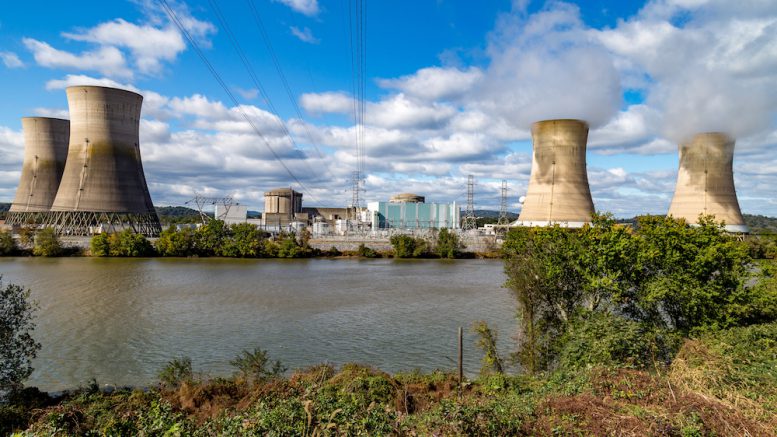Silicon Valley CEOs can get obsessed with some pretty weird things — colonizing Mars, ultra-ascetic diets, wearing the same outfit every single day, or living forever.
But there’s nothing head-scratching about the latest preoccupation shared by some of the biggest tech companies, including Amazon and Microsoft: nuclear power.
Both companies have inked deals this year to lock down supplies of the climate-friendly, reliable energy they’ll use to power the huge data centres that host, store and process the vast amount of information on which their services run.
Such demand for nuclear-generated electricity, magnified by the immense power needs of artificial intelligence (AI), will no doubt grow. Microsoft, which has reportedly invested more than US$13 billion in OpenAI, the creator of ChatGPT, and has been quick to incorporate AI into some of its offerings, is seeking to double its existing server capacity of 5 gigawatts (GW), Business Insider reported in April.
It has a big mountain to scale though — especially since it’s promised to be carbon negative by 2030, in only six years’ time.
With the clock ticking and its energy requirements climbing, it signed a deal in September to buy power from a restarted reactor at Three Mile Island in Pennsylvania. The 835-megawatt (MW) reactor was unaffected by the partial meltdown at its neighbouring Unit 2 plant in 1979 — still the worst nuclear accident in U.S. history — and had been in operation continuously from 1985 until 2019. It closed five years ago because of high costs. Terms of the 20-year power purchase agreement with owner Constellation weren’t disclosed, but it does start in 2028.
While the deal is subject to regulator approval, it suggests nuclear energy will have a big part to play in a high-tech future. It was a point hammered home by Joe Dominguez, president and CEO of Constellation on announcing the Microsoft deal.
“Powering industries critical to our nation’s global economic and technological competitiveness, including data centers, requires an abundance of energy that is carbon-free and reliable every hour of every day,” Dominguez said in a release. “Nuclear plants are the only energy sources that can consistently deliver on that promise.”
Amazon Web Services, meanwhile, struck a US$650-million deal in March to buy a data centre next to another nuclear plant in Pennsylvania. The 960-MW data centre draws power directly from the 2.5-GW Susquehanna plant next door — rather than the grid.
Amazon has circled 2040 as the year its business will reach net zero.
‘Gargantuan’ need
Analysts pegged the Microsoft deal as significant for the nuclear sector.
“Whatever happens with this project, it confirms what many market participants have been suggesting for a while — that the AI companies’ power requirements in the near future will be so gargantuan that they cannot expect to depend on the grid for stable supply,” BMO Capital Markets commodities analyst Colin Hamilton said in a “Metal Matters” podcast in September.
By some estimates, U.S. data centres will need as much as 35GW of power by 2030, double the amount they needed in 2022, he noted.
“That might not sound like much, but it would be equivalent to around 9% of total electricity demand in 2030. And given how slow western governments can be to build out crucial infrastructure, it’s not surprising that some of the megacorps are looking to take things into their own hands,” Hamilton said.
Microsoft’s deal with Constellation alone will rachet up the pressure on the uranium market, which can’t easily scale up supply, Canaccord Genuity mining analyst Katie Lachapelle said on Sept. 23.
“In our view, this adds incremental demand into an already tight market (more than 400,000 lb. U3O8 per year),” she wrote in a report, Uranium: Power required for energy hungry world. “It is also a clear signal to us that big tech is serious about collaborating with energy providers to develop carbon-free energy sources to help meet growing grid demands (data centre/AI driven).”
Lachapelle also cited a peer-reviewed analysis in scientific journal Joule that showed AI chip maker NVIDIA could ship 1.5 million AI server units per year by 2027.
“Those servers, running at full capacity, would consume at least 85.4 terrawatt-hours (TWh) of electricity annually — more than what many small countries use in a year,” she wrote. “No wonder the likes of Amazon, Microsoft, and OpenAI are recognizing not only the low carbon nature of nuclear energy, but also the tiny geographical footprint per MW. In our view, a nuclear renaissance in the West could be data driven.”
The analyst also notes an opportunity in uranium stocks, now trading at a 25% discount to both the spot and term prices. They’ve slid 8% so far this year, in contrast to an 18% rise in reported term prices for the metal, she said. Lachapelle forecasts a US$90 per lb. U3O8 long-term price (it currently sits around US$80 per lb.) as utilities come to accept supply won’t ramp up as quickly as demand.
Small reactors, big data
Big tech’s attentions — and cash — are also likely to help fast-track small modular reactor (SMR) technology.
SMR units, which produce less than 300 MW of energy (with some generating as little as 1-10 MW, have been on the horizon for years. Remote mine sites were previously seen as a top prospect. But big tech now seems a more likely first customer.
Sundar Pichai, CEO of Google and its parent company Alphabet, signalled in a speech in September that the company sees nuclear as part of the mix to get it there. Pichai said he’s optimistic about the potential to use SMRs to power data centres of 1 GW or more, given the amount of investment pouring into the space.
Google has pledged to switch completely to carbon-free energy sources by 2030.
Hamilton noted that while poor economics have hampered the development of SMRs, that may not deter big tech.
“It could be that some of the tech companies may be willing to overlook higher unit prices if it offers them the one thing they are so desperate for: low-carbon energy security.”




Be the first to comment on "Big tech’s nuclear option"